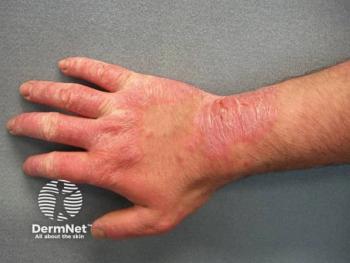
Road to RAD: The Ins and Outs of Managing CHE
Key Takeaways
- Accurate diagnosis of chronic hand eczema is crucial for effective treatment, with patch testing aiding in distinguishing underlying causes.
- Topical corticosteroids are widely used for CHE due to affordability and insurance coverage, but non-steroidal options remain off-label.
Jonathan Silverberg, MD, PhD, MPH, shares his insights on treating and managing CHE.
In a recent interview with Dermatology Times, Jonathan Silverberg, MD, PhD, MPH, associate professor of dermatology at George Washington University School of Medicine and Health Sciences, emphasizes the importance of accurately identifying the underlying etiology of chronic hand eczema (CHE). He noted that hand eczema can arise from a range of dermatological conditions, including irritant contact dermatitis, allergic contact dermatitis, and atopic dermatitis. Proper diagnosis is essential for effective treatment planning, and diagnostic tools such as patch testing can be especially helpful in distinguishing among these different causes.
When it comes to treatment, Silverberg acknowledges that topical corticosteroids are commonly used due to their affordability and widespread availability, especially in terms of insurance coverage. However, he points out a significant gap in the availability of approved nonsteroidal topical therapies for CHE. Currently, any use of nonsteroidal treatments is considered off-label, meaning these medications are not officially approved for this specific condition.
Despite this, clinicians often turn to a variety of topical agents in their therapeutic toolbox. This may include topical calcineurin inhibitors, which have long been used off-label for eczema management. Additionally, some newer topical treatments that have recently received approval for atopic dermatitis may be considered as options for patients with CHE. Nevertheless, Silverberg underscores that robust clinical data supporting the efficacy of these newer agents specifically for hand eczema are still lacking.
Silverberg, a cochair of the Revolutionizing Atopic Dermatitis (RAD) Conference this week, will be presenting on a number of topics, including new and upcoming therapies, managing itch, and more. He will be joined by cochair Raj Chovatiya, MD, PhD, MSCI; Dermatology Times Editor in Chief Christopher Bunick, MD, PhD; Mona Shahriari, MD; and even more experts in the field. With presentations on everything from dose flexibility to late-breaking research, there is sure to be something for everyone at RAD 2025.
Want to hear more pearls and expert insights on AD? Join us at the annual
For more expert insights on the topic, check out our
Newsletter
Like what you’re reading? Subscribe to Dermatology Times for weekly updates on therapies, innovations, and real-world practice tips.



















